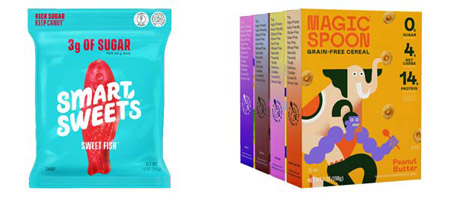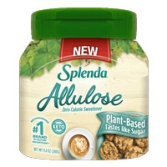Allulose is a rare sugar found in nature in very small quantities. What makes it different is that has a very similar taste and texture to sugar, but only a fraction of the calories.
This makes it an ideal choice for those seeking to maintain a healthy weight as well as for those with diabetes or on a low-carb or keto diet, while still wanting to enjoy the indulgent experience of sugar.
Get all the facts about allulose in our FAQ and learn more here!
Where does allulose come from?
Allulose was first identified in the leaves of wheat in the 1940s and has since been found in small quantities in certain fruits including figs and raisins, as well as in maple syrup.
Unlike regular sugar (sucrose), it has no impact on blood glucose or insulin levels, making it an ideal alternative for those with, or at risk of, type 2 diabetes. It is also virtually calorie free, with just 10% of the calories of sugar, making it a great tool for weight management.
How is allulose made?
We were the first company to find a way to manufacture allulose on a commercial scale in a cost-efficient way. We began manufacturing allulose syrup in the United States in 2016.
Our proprietary process involves a series of steps which allow us to convert corn kernels into starch, then the starch into fructose and from there into DOLCIA PRIMA® Allulose. We manufacture allulose as a crystalline product (similar to granulated sugar) and as a liquid syrup.
What makes allulose a great replacement for sugar (sucrose)?
In addition to the fact that it has only a fraction of the calories of sugar and no impact on blood glucose, what makes allulose such a game-changer are all the similarities it has with sugar.
For example, it has a similar taste and sweetness level to sugar: allulose is 70% as sweet, compared with alternative sweeteners that can be up to 600 times as sweet. This makes allulose a more direct replacement for sugar in recipes.
Importantly, it also behaves in a very similar way to sugar in a recipe. Sugar plays many important roles in food and drink besides just adding sweetness and taste. For example, it adds bulk, ensuring the right texture and mouthfeel. It also gives the nice caramel colour we expect from baked goods like cakes and cookies. Allulose can replicate both of these functions, and it also freezes like sugar, all of which makes it a more direct and straightforward replacement for sugar.
What’s the difference between allulose and other low-calorie sweeteners like stevia or monk fruit?
Allulose is unique in that it not only provides a similar sweet taste as sugar but also replicates several of its functionalities. Other types of sweeteners – including “high-intensity” sweeteners such as stevia – can be many times sweeter than sugar. They therefore have to be used in much lower quantities, which in turn means that food and drink manufacturers need to include additional ingredients (e.g. other sweeteners, fibre or texturisers) to build back the bulk and provide the expected colour and texture.
Is allulose safe?
Allulose is a naturally occurring sweetener that is perfectly safe for human consumption.
It is “Generally Recognized As Safe” by the US Food and Drug Administration (FDA), the body responsible for food safety in the US. The relevant authorities in Singapore, the Philippines and several Latin American countries have also approved the ingredient. Its approval is supported by a significant body of safety data and human clinical trials.
Moreover, allulose is free from some of the negative effects of excessive sugar consumption. It is non-cariogenic, i.e. it doesn’t lower the pH in your mouth so doesn’t increase the risk of dental caries. The body absorbs allulose but does not metabolise it, which is why it has a close to zero calorie content and can therefore support weight loss. It also has the benefit of not raising blood glucose or insulin levels.
Why is allulose only available in certain countries?
Allulose only came to market in 2015 and has been approved for use in the US, Singapore, the Philippines and several Latin America countries, including Chile, Colombia, Ecuador, Peru and Mexico. Different countries follow different processes for approving a new food ingredient, so the time it takes to obtain approvals varies. It is expected that the approval process will be completed in other countries over the coming years.
Is allulose suitable for those following a low-carb or keto diet?
Yes. Allulose is low carb and keto-friendly, which is particularly useful since other sweeteners like table sugar, honey and maple syrup are off the menu for those following a low-carb diet. Allulose passes through the body without being metabolised, which means it has very few calories.
In the US, allulose is not counted towards “total sugars” or “added sugars”, in line with FDA guidance.
What kind of products contain allulose?
For all of the above reasons, allulose is becoming increasingly popular as a sweetening ingredient in the US and beyond and we are seeing strong growth in product launches containing allulose. It is being used in particular in snack bars, ice cream and cereals.
Some popular examples include SmartSweets and Magic Spoon breakfast cereal.
Is it possible to buy packs of allulose to use when cooking at home?
Yes. At Tate & Lyle, we focus on supplying our DOLCIA PRIMA® Allulose to food and drink manufacturers who use it in their products. But it is also available for purchase as a sweetening ingredient to use at home.
In the United States, for example, SPLENDA® Allulose is available and can be used as a 1-for-1 replacement for sugar in baked goods.
How does allulose fit into Tate & Lyle’s company purpose of “Improving Lives for Generations”?
Our company purpose is made up of three pillars: supporting healthy living, building thriving communities and caring for our planet. Supporting healthy living includes helping people make healthier and tastier choices when they eat and drink.
Allulose can help create healthier, sugar-reduced food and drink with the same great taste we are used to. It is part of a comprehensive sugar reduction toolbox that enables food and drink manufacturers to develop new products and reformulate existing ones to give consumers healthier and still delicious options.
As of March 2020, our low-/no-calorie sweeteners and fibres had helped remove 1.7 million tonnes of sugar from people’s diet, equivalent to 6.8 trillion calories. Our goal is to increase this to 9 million tonnes of sugar and 36 trillion calories by 2025.
Learn more about our purpose here: https://www.tateandlyle.com/purpose
You might also be interested in:
The low carb craze - what's it all about?
Tate & Lyle's Nutrition Centre
Disclaimer: The applicability of label claims, health claims, and the regulatory and intellectual property status of our ingredients varies by jurisdiction. [Food and beverage] Manufacturers should obtain their own advice regarding all legal and regulatory aspects of our ingredients and their usage in their own products to determine suitability for their particular purposes, claims, freedom to operate, labelling or specific applications in any particular jurisdiction.
SPLENDA® and the SPLENDA® logo are trademarks of Heartland Consumer Products, LLC
1 Mintel GNPD, new product launch 4-year CAGR of +86% (2015-2020).




